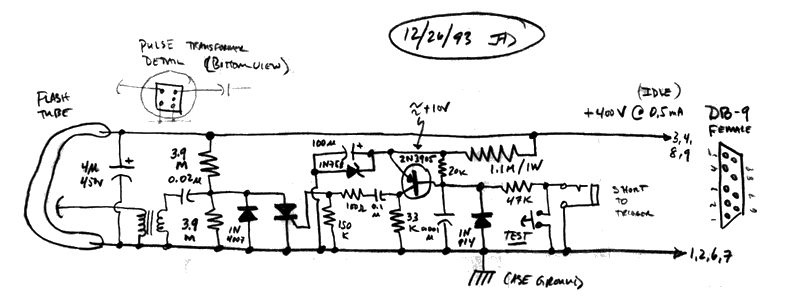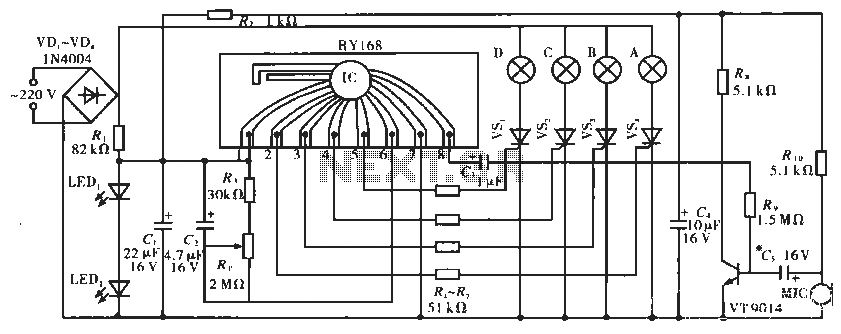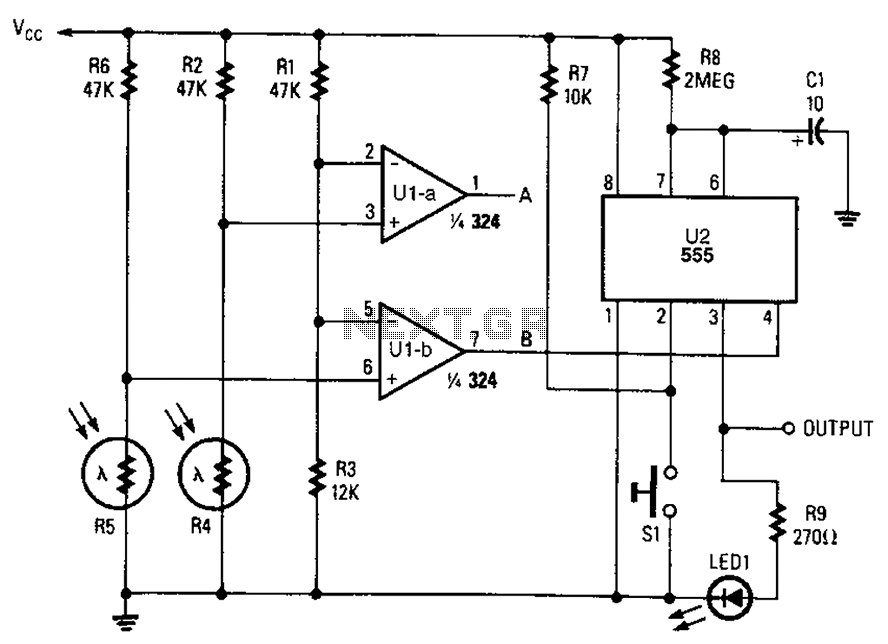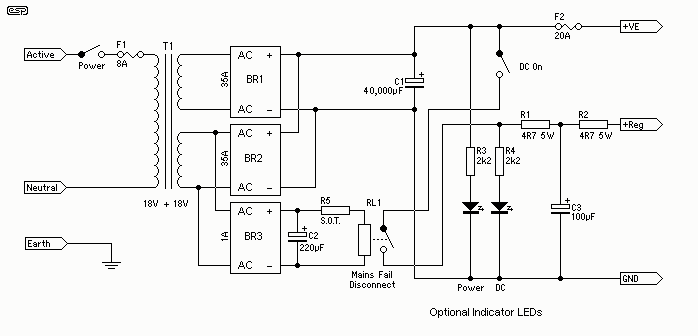
High Speed Photography Strobe Light

To capture high-speed photographs, a fast shutter or light source is essential. This project involved examining a commercial flash unit to analyze its light profile. A phototransistor was connected in an emitter follower configuration with a low impedance emitter resistor, which was exposed to the flash while monitoring the resistor voltage with an oscilloscope. Due to the lack of a fast digitizer or camera, the observed trace was sketched by hand. The resulting data indicated that the pulse length was approximately 175 µs, which is too long for capturing fast-moving objects. For instance, an object traveling at 130 m/s (295 mph) would cover 22 mm during this duration. Consequently, a new light source was developed with a shorter pulse length. A U-shaped xenon flash lamp and a pulse transformer were sourced from a local Radio Shack, along with high voltage capacitors. A high voltage power supply, previously built for another project, was also available. A reflector from a handheld lantern was modified to accommodate the flash lamp and was secured to a small plastic box using epoxy. The electrical components were mounted inside the box, featuring a male DB-9 connector for the high voltage source, a "short-to-fire" connector with a female 1/8" phone jack, and a momentary contact switch for testing. The homemade strobe flash unit produced a light curve with a pulse length of approximately 30 µs, significantly shorter than the commercial unit. The homemade unit emitted about one-fifth of the total light output of the commercial unit. The electrical schematic of the strobe light shows a high voltage (400 VDC maximum) applied to a main capacitor (4 µF, 450 V), which is directly connected to the flash lamp. Heavy, low inductance straps minimize the effect on the flash pulse length. The pulse transformer is configured as a step-up, with its high voltage secondary connected to the lamp's ionization electrode. The primary is connected to a smaller capacitor (0.02 µF, 300 V) through a high impedance voltage divider. During operation, this capacitor charges to half the main voltage through the divider and discharges through the transformer's primary by momentarily shorting the divider to ground via a silicon-controlled rectifier (SCR, 400 PIV, 4 A). The rest of the circuit includes a single transistor amplifier and a pulse-forming circuit that generates a sharp pulse to trigger the SCR's gate, activated by either the "push-to-test" switch or by shorting the contacts of the jack.
The design of the homemade strobe flash unit emphasizes the need for a compact, efficient, and high-speed light source for capturing fast-moving subjects. The use of a U-shaped xenon flash lamp allows for a significant reduction in pulse duration, making it suitable for high-speed photography. The integration of a pulse transformer not only boosts the voltage necessary to ionize the lamp but also ensures that the energy delivery is rapid and efficient. The choice of components, including the capacitors and the SCR, reflects a careful consideration of the circuit's performance under high voltage conditions.
The pulse-forming circuit, which includes a single transistor amplifier, plays a critical role in ensuring that the SCR is triggered effectively, producing a sharp and precise pulse that activates the flash lamp. The implementation of a momentary contact switch for testing purposes allows for easy verification of the circuit's functionality without the need for continuous operation.
Overall, this schematic represents a practical approach to building a high-speed light source, demonstrating how readily available components can be utilized to create an effective solution for capturing fleeting moments in photography. The resulting light curve, with its significantly reduced pulse length, illustrates the effectiveness of the design in achieving the desired performance.In order to take a high speed photograph one must either have a very fast shutter or light source. We followed the latter course and first examined an commercial flash unit to determine its light profile. This was accomplished by exposing a phototransistor connected in an emitter follower configuration with a relatively low impedance emitter resistor to the flash and viewing the resistor voltage
with an oscilloscope. Since we did not have a fast digitizer or camera available the observed trace was roughly hand sketched. The figure to the left shows the observed data. The phototransistor circuit appears in the right of the figure and the light curve of the commercial flash unit is shown at the lower left.
It can be seen that the pulse length is around 175 µs which is far too long. For example, a 130 m s-1 object (295 mph) will travel 22 mm in that time. We set about to build our own light with a significantly shorter pulse length. Fortunately, a U-shaped xenon flash lamp and companion pulse transformer were available from a local Radio Shack (and still are although the pulse transformer is now a special order item) and there were a few high voltage capacitors in the junk box. A high voltage (several hundred volt) power supply was also laying about which was built for another project at least twenty years ago.
A very nice reflector was obtained from a hand-held lantern, drilled out to pass the flash lamp, and attached to a small plastic box with epoxy. The electrical components were mounted free-standing inside the box, a male DB-9 connector was used to connect to the high voltage source, a "short-to-fire" connector was implemented with a female 1/8" phone jack, and a momentary contact switch was utilized as a "push-to-test" button.
The following figure shows a collection of views of the home-made strobe flash unit. The resulting light curve for this home-made unit is also shown in the figure at the top of this page. The pulse length is approximately 30 µs, about one-sixth of the commercial unit. The relative areas of the two curves can be compared to determine the change in relative exposure. The home-made unit emits about one-fifth of the total light of the commercial unit. The electrical schematic of the strobe light is shown in the figure below. The high voltage (400 VDC, maximum) is applied directly to the main capacitor (4 µF, 450 V) which is directly connected to the main terminals of the flash lamp.
The connections between the capacitor and lamp are relatively heavy, low inductance straps to minimize their effect on the flash`s pulse length. The pulse transformer is set in a step-up configuration and its high voltage secondary is connected to the ionization electrode of the lamp.
The low(er) voltage primary is connected to a smaller capacitor (0. 02 µF, 300 V) through a very high impedance voltage divider. In operation, this capacitor charges to one-half the main voltage through the divider and is discharged through the transformer`s primary by momentarily shorting the divider to ground by a silicon-controlled rectifier (SCR, 400 PIV, 4 A) The rest of the circuit is a single transistor amplifier and pulse-forming circuit which generates a sharp pulse with sufficient current to trigger the SCR`s gate. It will be activated either by depressing the "push-to-test" switch or by shorting out the contacts of the jack.
🔗 External reference
The design of the homemade strobe flash unit emphasizes the need for a compact, efficient, and high-speed light source for capturing fast-moving subjects. The use of a U-shaped xenon flash lamp allows for a significant reduction in pulse duration, making it suitable for high-speed photography. The integration of a pulse transformer not only boosts the voltage necessary to ionize the lamp but also ensures that the energy delivery is rapid and efficient. The choice of components, including the capacitors and the SCR, reflects a careful consideration of the circuit's performance under high voltage conditions.
The pulse-forming circuit, which includes a single transistor amplifier, plays a critical role in ensuring that the SCR is triggered effectively, producing a sharp and precise pulse that activates the flash lamp. The implementation of a momentary contact switch for testing purposes allows for easy verification of the circuit's functionality without the need for continuous operation.
Overall, this schematic represents a practical approach to building a high-speed light source, demonstrating how readily available components can be utilized to create an effective solution for capturing fleeting moments in photography. The resulting light curve, with its significantly reduced pulse length, illustrates the effectiveness of the design in achieving the desired performance.In order to take a high speed photograph one must either have a very fast shutter or light source. We followed the latter course and first examined an commercial flash unit to determine its light profile. This was accomplished by exposing a phototransistor connected in an emitter follower configuration with a relatively low impedance emitter resistor to the flash and viewing the resistor voltage
with an oscilloscope. Since we did not have a fast digitizer or camera available the observed trace was roughly hand sketched. The figure to the left shows the observed data. The phototransistor circuit appears in the right of the figure and the light curve of the commercial flash unit is shown at the lower left.
It can be seen that the pulse length is around 175 µs which is far too long. For example, a 130 m s-1 object (295 mph) will travel 22 mm in that time. We set about to build our own light with a significantly shorter pulse length. Fortunately, a U-shaped xenon flash lamp and companion pulse transformer were available from a local Radio Shack (and still are although the pulse transformer is now a special order item) and there were a few high voltage capacitors in the junk box. A high voltage (several hundred volt) power supply was also laying about which was built for another project at least twenty years ago.
A very nice reflector was obtained from a hand-held lantern, drilled out to pass the flash lamp, and attached to a small plastic box with epoxy. The electrical components were mounted free-standing inside the box, a male DB-9 connector was used to connect to the high voltage source, a "short-to-fire" connector was implemented with a female 1/8" phone jack, and a momentary contact switch was utilized as a "push-to-test" button.
The following figure shows a collection of views of the home-made strobe flash unit. The resulting light curve for this home-made unit is also shown in the figure at the top of this page. The pulse length is approximately 30 µs, about one-sixth of the commercial unit. The relative areas of the two curves can be compared to determine the change in relative exposure. The home-made unit emits about one-fifth of the total light of the commercial unit. The electrical schematic of the strobe light is shown in the figure below. The high voltage (400 VDC, maximum) is applied directly to the main capacitor (4 µF, 450 V) which is directly connected to the main terminals of the flash lamp.
The connections between the capacitor and lamp are relatively heavy, low inductance straps to minimize their effect on the flash`s pulse length. The pulse transformer is set in a step-up configuration and its high voltage secondary is connected to the ionization electrode of the lamp.
The low(er) voltage primary is connected to a smaller capacitor (0. 02 µF, 300 V) through a very high impedance voltage divider. In operation, this capacitor charges to one-half the main voltage through the divider and is discharged through the transformer`s primary by momentarily shorting the divider to ground by a silicon-controlled rectifier (SCR, 400 PIV, 4 A) The rest of the circuit is a single transistor amplifier and pulse-forming circuit which generates a sharp pulse with sufficient current to trigger the SCR`s gate. It will be activated either by depressing the "push-to-test" switch or by shorting out the contacts of the jack.
🔗 External reference





